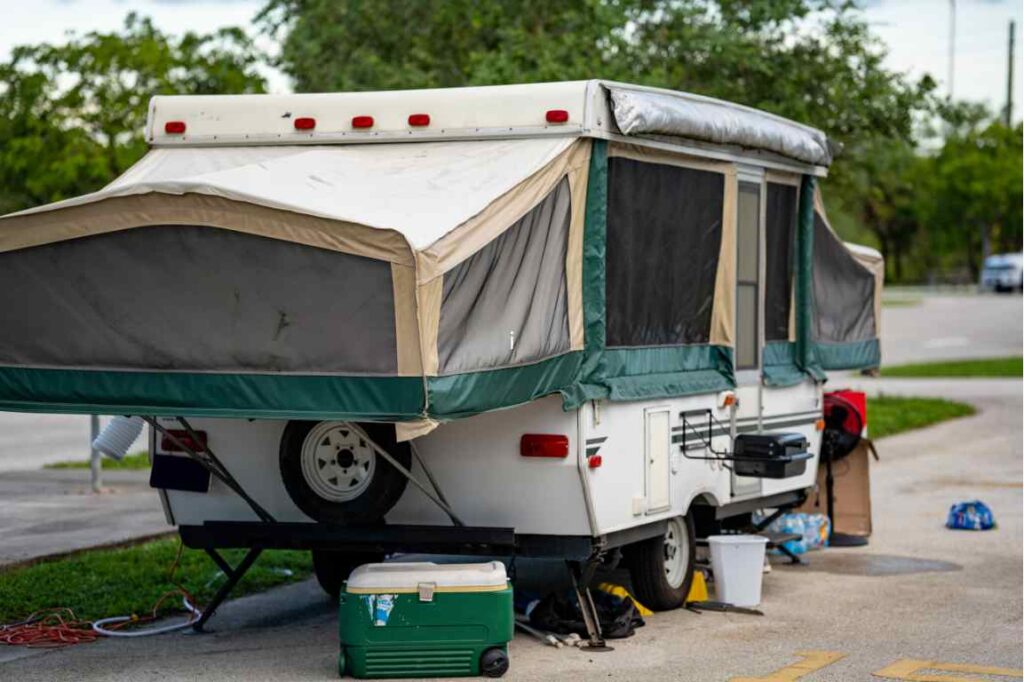A pop-up camper can last 15 years or longer, provided you care for it well. One of the first parts of the trailer that can go is the canvas, as it’s prone to environmental and road damage. How do you keep your pop-up camper canvas in its best condition?
Here are some tips for maintaining a pop-up camper canvas:
- Keep it clean
- Don’t leave product residue on the canvas
- Consider a cover
- Address small holes and tears promptly
- Let your camper dry out
- Treat mold and mildew
- Reapply waterproofing
- Watch where you park
This guide to revitalizing your camper canvas will provide instructions, tips, and product recommendations so your camper can look as good as new, even if it’s already several years old!

8 Steps to a Cleaner Pop-Up Camper Canvas
1. Keep It Clean
The most important maintenance step is regularly cleaning the canvas of your pop-up camper.
Consistent cleaning every week or other week will remove debris, dirt, and grime before it can settle and leave stains and other unsightly marks. It’s a lot easier to deal with these messes when they’re fresh, as they’ll clean up with less elbow grease.
A lighter hand is always better than a heavier one when tidying up camper canvas. Heavy-duty products or harsh scrubbers could wear away the fabric, leading to loose threads and holes.
So how do you clean the canvas, anyway? It’s simple and doesn’t require chemicals. You only need water and vinegar, one part of vinegar to two parts of water.
Vinegar is one of my favorite cleaning products because it’s versatile and gentle on surfaces but not on messes. The acetic acid in vinegar–five percent of its makeup–can break down bacteria, stains, films, oils, and dirt.
You shouldn’t have to stress about vinegar eating away at your pop-up camper canvas. However, there’s nothing wrong with being completely confident, so dab a bit of vinegar on the underside or corner of the canvas before you begin.
Does the canvas pass the test? Great! You can continue cleaning.
You need a scrub brush for this project. I recommend the DocaPole. Its telescoping handle can extend between five and 12 feet to reach every corner and crevice of your pop-up camper canvas.
Dip the brush into the bucket with the water and vinegar, shake out the excess, and rub away any stains and messes.
2. Don’t Leave Product Residue on the Canvas
It’s critical you thoroughly rinse the canvas when you’re done. You know vinegar can damage some materials, so it’s not wise to leave any vinegar residue on the flexible plastic or woven material.
That goes double for any chemical cleaners you use. You must remove the residue entirely to prevent stains and unnecessary wear and tear on the fabric.
You can always use your telescoping scrub brush for residue. Dunk it in a bucket of clean water until it’s clean, then go over all the areas you cleaned.
Much more conveniently, you can plug in a garden hose, turn it on to a low setting, and remove residue that way.
Here’s another pointer: don’t clean your camper on a sunny day. I know this seems strange, as you’ll want the sun to help the canvas dry.
However, the sun can cause it to dry too quickly, sealing residue onto the camper that you’ll have to work harder to remove.

3. Consider a Cover
Pop-up camper canvas sort of is its own cover in a way, right? Therefore, it might seem silly to some of you reading this to consider an external cover for your vehicle.
However, I stand by that recommendation. Exposure to the elements is one of the fastest ways to degrade the canvas. The sun can fade it, rain and snow can wear away a water-resistant coating (more on this to come, don’t you worry), and bird poop and sap can leave stains.
A cover protects your camper from the elements whenever you take a break from the road, whether for a few hours or months. And yes, before you ask, you can buy covers made for pop-ups, and they’re usually cheaper than RV covers.
This pop-up camper cover from DikaSun checks all my boxes. It’s large enough to fit most models, up to 10 feet. It’s made of six layers to protect your trailer from weather, yet it’s breathable.
It’s waterproof, so rain and snow can’t saturate, and it’s windproof to keep the cover secure all season long. Bests of all, the DikaSun pop-up camper cover is UV-resistant.
Covers without UV resistance don’t safeguard your camper from the sun. The sun’s rays can permeate the fabric, fading your trailer for months.
This polypropylene cover breathes well, which is important. It has four mesh air vent panels to allow humid air out.
The air under the cover can get warm, even if you park your RV in a cold climate. Ventilation allows it to escape before humidity and condensation build up and wreak havoc.
4. Address Small Holes and Tears Promptly
Uh-oh, is that a tear you see in your camper canvas? I wrote an entire guide on what to do when rips and holes happen, so this section will largely be a recap.
What causes holes? Environmental damage can do it. If your camper canvas endures too much sun exposure or weather damage, the fabric can weaken and eventually give way. Tree branches and other sharp debris can catch on the canvas and snag, creating a long rip.
Get into the habit of checking your canvas every week, or even better, at the conclusion of every road trip. I know that sounds a little obsessive, but it’s necessary. Catching small tears early is the difference between a fast, easy patch job and a more complex, time-consuming project.
Ideally, you’ll notice the canvas damage when it’s still loose and frayed strings, but if that time has come and gone and you’re faced with a hole, don’t panic. It’s easily fixable.
A small piece of RV awning repair tape will take care of it. I also quite like the Outfitters Supply pop-up camper canvas repair kit, which includes six ounces of Tear Mender Glue. The glue is clear and will be less unsightly than the tape.
The repair kit also has sewing needles, an awl, and spare canvas. You shouldn’t need those tools if you have a small rip, as you can pinch the canvas together, apply the glue or tape, then smooth it over.
However, once your holes are several feet long, you have no choice but to put a fabric patch over the gaping hole. You can glue or sew the patch into place.
How easy a time you’ll have finding a replacement patch depends on the look of your camper canvas. If yours is a standard color, any repair kit should have what you need. A custom canvas will require you to go to the manufacturer and request more material.
5. Let Your Camper Dry Out
One of the most detrimental mistakes you can make when maintaining a pop-up camper canvas is retracting it prematurely. Whether you just gave your trailer a good scrub-down or it sat out in heavy rain, you can’t fold it down until it dries out.
Remember how I talked about humidity accumulating underneath a trailer cover? The same premise applies to those compressed parts of the camper canvas. The folds are wet, dark, and warm, three qualifiers for mold and mildew growth.
Perhaps you won’t see any fungi on your camper canvas the first time or two you retract it when wet, but trust me, it will happen eventually.
I know it takes extra time to let the canvas sit out and dry. You could wait for hours depending on the weather and how much breeze you have. I would recommend building that time into your cleaning routine.

6. Treat Mold and Mildew Right Away
Perhaps you didn’t realize how important it is to keep your pop-up camper open when wet, and you ended up with a bit of a mold problem. Most molds that form on the canvas will be streaky and black but can also appear gray or white and have a fuzzy texture.
How do you remove the mold while preserving the tent fabric? You have a couple of solutions.
One is water and vinegar again. Use the same mixture as before to treat the mold. A telescoping scrub brush is a good tool here, but you might have to scrub a bit harder than everyday cleaning. Please use a soft sponge to avoid damaging the fabric further.
Did the vinegar not quite cut it? You can create a more potent mixture by combining water with bleach and dish soap. However, I would only recommend this for white canvas, as bleach will stain other colors, leaving you with a bigger mess than what you originally started with.
Before you jump to the bleach cleaner, I’d suggest trying Star Brite’s Mold & Mildew Stain Remover. This RV-safe product can treat mildew and mold stains on myriad surfaces, tent fabric among them.
You’ll also find it handy for vinyl, RV bathrooms, plastic, rubber, porcelain, grout, and tile.
You can pour the Mold & Mildew Stain Remover into a spray bottle or a bucket and dip a clean sponge or cloth in. Give the product a few minutes to work, watching as the mold stains vanish. Clean the residue with water.
According to Star Brite, you should only need one application to take care of mildew and mold stains. However, stubborn or severe stains might need two rounds. You can scrub lightly on the second application.
7. Reapply Waterproofing
Most pop-up camper canvas is water-resistant instead of waterproof. The difference comes down to how it’s made.
For example, waterproof canvas is woven to repel water over the life of the canvas. Water resistance is from a coating that eventually wears away. When it does, you must reapply, or when your camper gets wet, it will become a hotbed for mildew and mold.
303 Fabric Guard is a water-repellant spray. It comes in a 16-fluid-ounce bottle, so maybe order two if you haven’t ever waterproofed your camper canvas before.
I love this product because it also doubles as a stain repellant, so you won’t have to stress the next time a bird leaves droppings on your pop-up.
Test how it works on a small piece of fabric before using all over. 303 Fabric Guard is safe on most upholstery, including from Sunbrella, but it’s better to be safe than sorry.
8. Watch Where You Park
My last tip for maintaining your pop-up camper canvas is this: park carefully. Your cleaning efforts will stretch a lot further if you refrain from parking in direct sunlight or under trees. The trees can drop sap and branches that can damage the canvas.
If you must park your vehicle in the elements, bust out the cover when you’re not using your trailer.
Bottom Line
Maintaining a pop-up camper canvas means building a regular cleaning routine. Keeping the canvas spiffy will reduce the elbow grease you must put into removing stubborn sap or droppings.
The next most important habit to roll into your routine is allowing the canvas to dry in between cleanings. Mold and mildew will catch up with you if you retract your camper while it’s still wet often enough!
